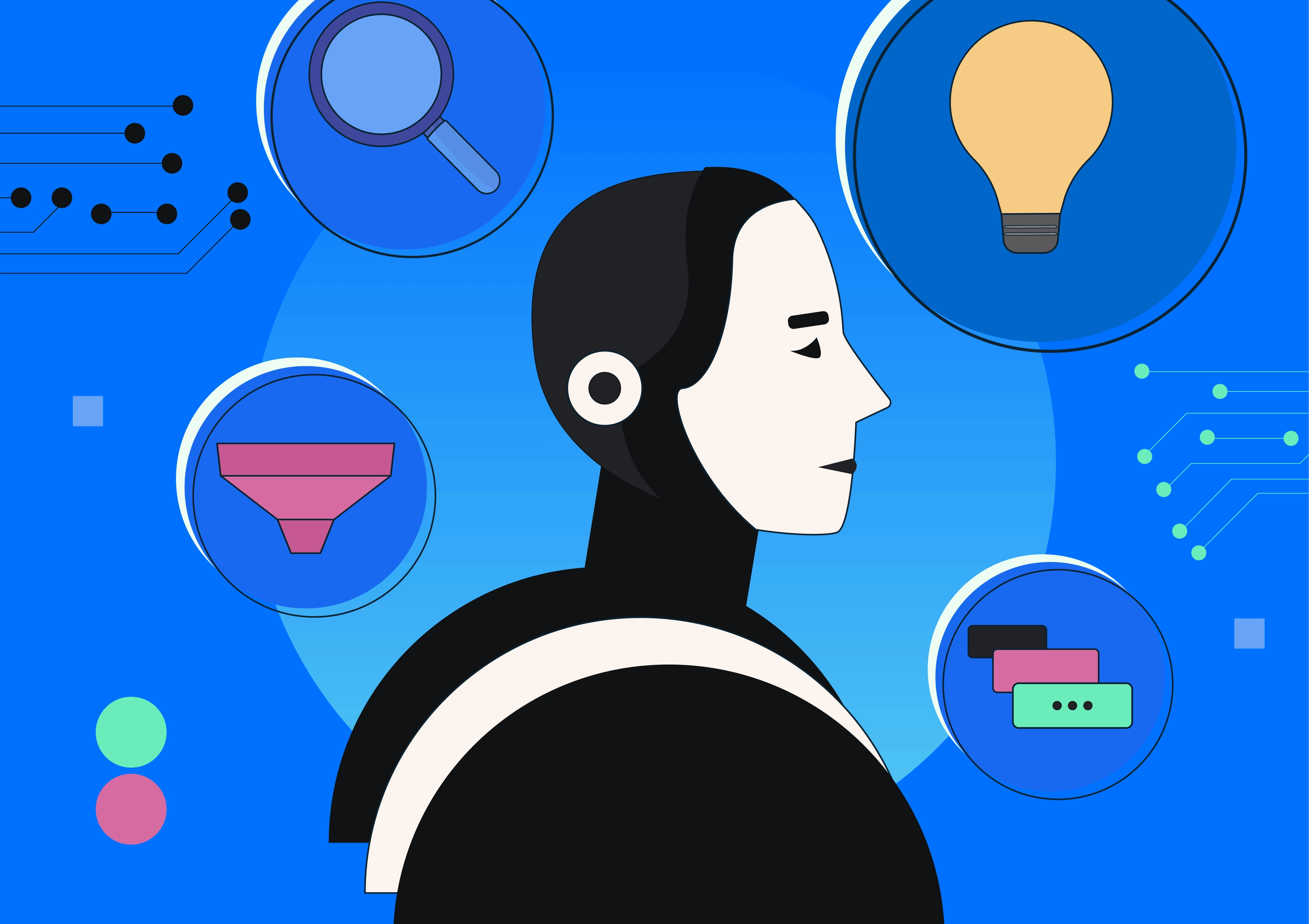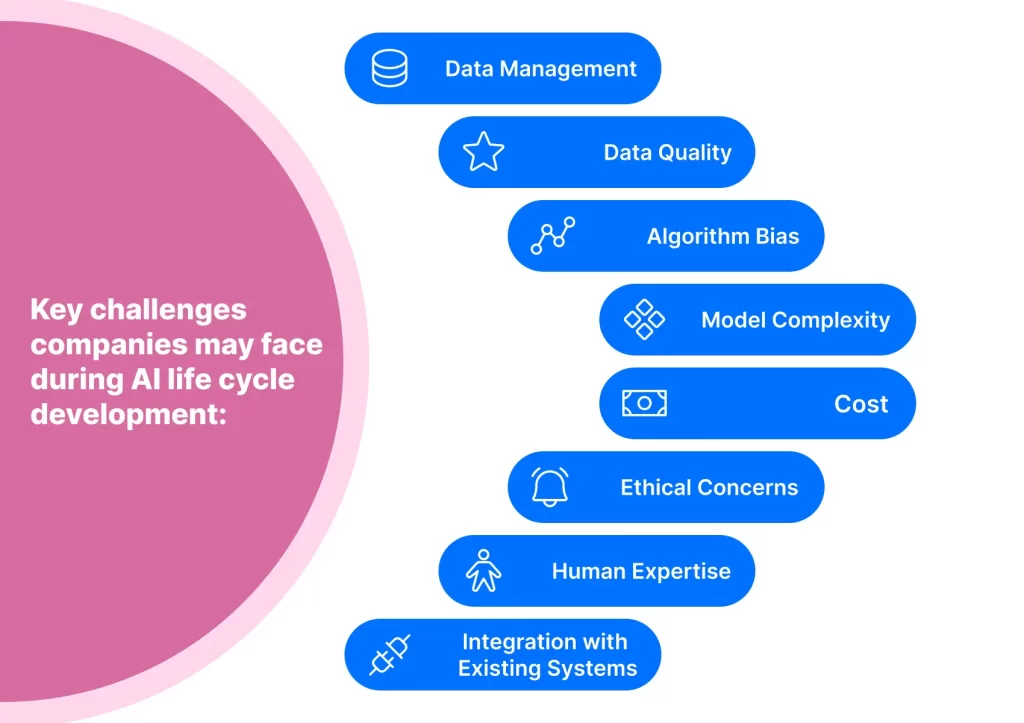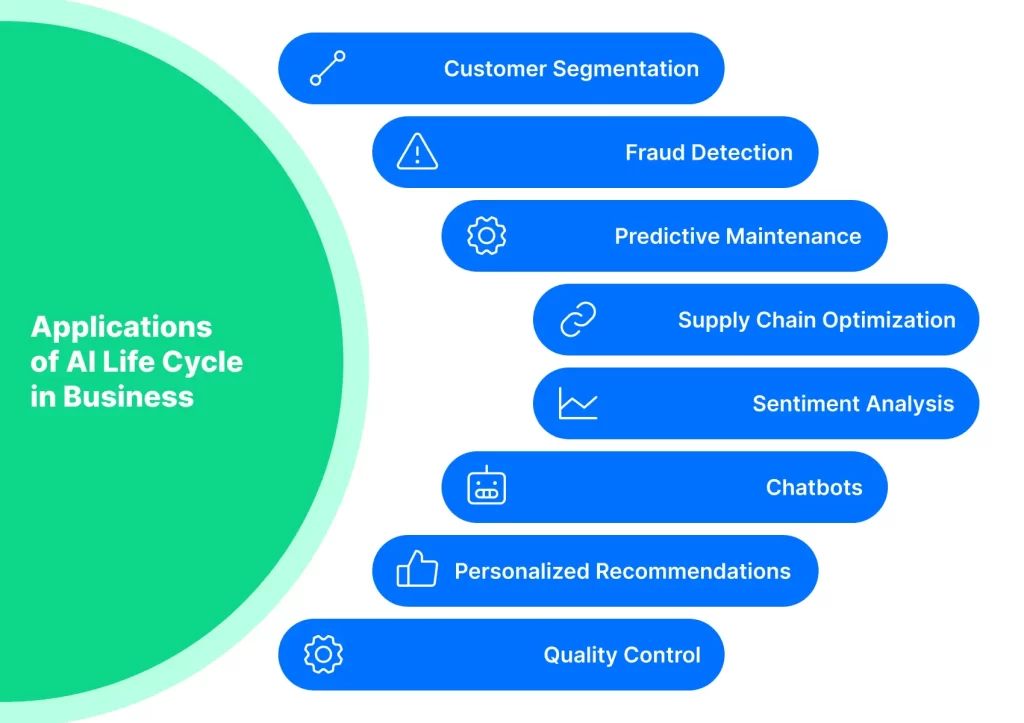The AI Life Cycle: Navigating the Stages for Business Success

Artificial Intelligence (AI) has rapidly become an essential part of businesses across all industries, from healthcare to finance to e-commerce. However, building an AI system involves a complex process known as the AI life cycle. From data collection to model development, testing, and validation, deployment and integration, each stage of the AI lifecycle plays a crucial role in developing an AI system that delivers accurate and reliable results.
Alternative-spaces is an expert provider of AI lifecycle services, offering businesses across various industries a comprehensive range of AI solutions to help optimize their operations, achieve their goals, and stay ahead of the competition. In this article, we will delve into the AI life cycle and explore how Alternative-spaces’s expertise can benefit businesses looking to harness the power of AI.
Table of contents
- Main Stages of AI Life Cycle
- The Benefits Of AI Life Cycle For Businesses
- What Challenges May Businesses Face During AI Life Cycle Development?
- Applications of AI Life Cycle in Business
- What to Expect From AI Life Cycle in Future
- Summing up
- FAQ
Main Stages of AI Life Cycle
The AI life cycle consists of several essential stages for an AI system’s development, deployment, and successful operation. Each stage is interconnected with the others, and every step is critical to ensure the success and longevity of the AI system. So, here are the main stages with tools and metrics used.
Data Collection
The first stage of the AI life cycle is data collection. This stage involves gathering large datasets from various sources, including structured and unstructured data. The data could be anything from customer reviews to sensor readings to medical records. The quality of the data is critical as it directly affects the accuracy of the AI model. For example, a healthcare provider could collect patient data like medical histories, test results, and treatment outcomes.
- Tools: Web scraping tools such as BeautifulSoup, Scrapy, or Selenium.
- Metrics: Data completeness, accuracy, consistency, uniqueness, and validity.
Model Development
The second stage of the AI life cycle is model development. In this stage, the machine learning algorithms use the data collected in the first stage to identify patterns and relationships within the data. This process requires significant computational power and specialized software, as the algorithms run through millions of data points to develop the AI model. For instance, a team of data scientists could develop an AI model that predicts which products will most likely be purchased by customers based on their browsing habits.
- Tool: Python libraries such as Scikit-learn, TensorFlow, and PyTorch.
- Metrics: Accuracy, precision, recall, F1 score, AUC-ROC, Mean Squared Error (MSE), Root Mean Squared Error (RMSE), Mean Absolute Error (MAE), Confusion Matrix..
Model Testing and Validation
The third stage of the AI life cycle is model testing and validation. In this stage, the AI model is tested against new data to ensure that it can handle new situations and scenarios effectively. This process also involves identifying any errors in the model, which are then corrected before moving on to the next stage. For example, an e-commerce website might test an AI-powered product recommendation algorithm with a set of test users who engage with the site differently.
The testing and validation stage of the AI life cycle is a critical step to ensure that the developed machine learning models are accurate, reliable, and effective. Here are some examples of tools and metrics that can be used in this stage:
Tools:
- Python libraries such as Scikit-learn, Keras, and TensorFlow for building and testing machine learning models.
- Testing frameworks such as PyTest, Nose, and Robot Framework for automated testing.
- Model explainability tools such as LIME and SHAPE for interpreting and explaining model predictions.
Metrics:
- Accuracy: Measures how well the model predicts the outcome of a given input.
- Precision: Measures the proportion of true positives compared to all positive predictions made by the model.
- Recall: Measures the proportion of true positives compared to all actual positive outcomes in the data set.
- F1 Score: A combination of precision and recall that measures the overall accuracy of the model.
- Confusion Matrix: A table that shows the number of true positives, true negatives, false positives, and false negatives generated by the model.
- Receiver Operating Characteristic (ROC) Curve: A curve that summarizes the performance of a binary classification model over all possible decision thresholds.
- Lift Curve: Evaluates the effectiveness of a predictive model at identifying the top candidates in a group, relative to a random selection.
- Mean Squared Error (MSE): A measure of the average squared difference between the predicted and actual target values.
Using these tools and metrics during the testing and validation phase can help organizations ensure that their ML models are accurate, reliable, and effective.
Deployment and Integration
The fourth stage of the AI life cycle is deployment and integration. In this stage, the AI system is integrated into the platform or system where it will be used. This involves integrating the AI model with other systems, APIs, and databases to ensure seamless operation with existing infrastructure. For example, an online retailer might integrate its AI-powered product recommendation engine into its website’s backend.
- Tool: IBM Watson Machine Learning, TorchServe, TensorFlow Serving, Kubeflow.
- Metrics: Real-time processing speed, model uptime, and response time.
Monitoring
The fifth stage of the AI life cycle is monitoring. It involves closely monitoring the AI system’s performance, detecting anomalies, and identifying potential issues that could lead to errors or malfunctions. An example of this would be a bank monitoring its AI-powered fraud detection system for any suspicious activity.
- Tool: MLflow, TensorBoard, Kibana, and Prometheus.
- Metrics: Model accuracy, model efficiency, model robustness, and model fairness.
Retraining and Improvement
The sixth and final stage of the AI life cycle is retraining and improvement. As the system operates and new data becomes available, the AI model may need to be updated and refined to improve its performance. This stage involves collecting new data and using it to retrain the AI model, improving its accuracy and efficiency. For instance, a ride-sharing company might use new data to refine its AI-powered pricing model and adjust fares based on demand.
In conclusion, the AI life cycle is a crucial process that requires careful planning, execution, and monitoring throughout every stage. Data collection, model development, model testing and validation, deployment and integration, monitoring, and retraining and improvement are all equally important and must be executed carefully and thoroughly to ensure the success and longevity of the AI system.
The Benefits Of AI Life Cycle For Businesses
There are numerous ways artificial intelligence helps businesses, including increased efficiency, accuracy, and cost savings. Here are some key benefits of the AI life cycle for businesses:
- Improved Efficiency: The AI life cycle allows businesses to automate many tasks that were previously performed manually. This automation results in significant time savings and increased efficiency. For example, an e-commerce company can use an AI-powered chatbot to handle customer inquiries, freeing up customer service representatives to focus on more complex issues.
- Enhanced Accuracy: With the help of the AI life cycle, businesses can improve the accuracy of their processes and decision-making. AI models can analyze vast amounts of data with speed and precision, enabling businesses to identify patterns and insights that would be difficult to uncover manually. For instance, a financial institution can use AI models to detect and prevent fraudulent activities in real-time.
- Cost Savings: By automating tasks and improving efficiency, the AI life cycle can help businesses save money. For example, an online retailer can use an AI-powered inventory management system to optimize its stock levels, reducing the need for excess inventory and saving money on storage costs.
- Personalization: The AI life cycle allows businesses to provide personalized experiences to their customers. By analyzing customer data, AI models can make predictions about customer behavior and preferences, enabling businesses to tailor their offerings to individual customers. For instance, a streaming service can use AI models to recommend movies or TV shows based on a user’s viewing history.
- Scalability: One of the significant benefits of the AI life cycle is scalability. As a business grows, it becomes increasingly difficult to handle large amounts of data manually. With AI models and automation tools, businesses can scale-up their operations more easily. For example, an e-commerce store can use AI to process orders, track shipments, and handle returns, allowing them to scale-up operations quickly.
In conclusion, the AI life cycle can offer numerous benefits to businesses. From increased efficiency and accuracy to cost savings, personalization, and scalability, AI can help businesses optimize their operations, boost their revenues, and stay ahead of the competition.
What Challenges May Businesses Face During AI Life Cycle Development?

While the AI life cycle can offer many benefits to businesses, it has challenges. Here are some of the key challenges companies may face during AI life cycle development:
Data Management
One of the key aspects of AI development is having the right kind of data. Collecting, managing, cleaning, and labeling the data’s often a challenge. Data privacy, security, and integration can also pose challenges.
Data Quality
Data quality is vital in developing accurate AI models. However, businesses may struggle to gather and process high-quality data due to various reasons, including data silos, legacy systems, and poor data management practices.
Algorithm Bias
AI models can suffer from bias if they are trained on biased data or use biased algorithms. This can result in incorrect predictions or decisions that harm certain groups of people, potentially leading to legal issues and reputational damage.
Model Complexity
AI models can be incredibly complex and challenging to understand, especially when multiple models are used together. This can make it difficult for businesses to troubleshoot issues and identify opportunities for improvement.
Cost
Developing and deploying an AI system can be expensive, requiring significant investments in hardware, software, and personnel. This can be a barrier for smaller businesses or those with limited budgets.
Ethical Concerns
AI systems can raise ethical concerns, particularly around privacy and security. Businesses must ensure that their AI systems comply with ethical standards and regulations and safeguard against data breaches or malicious use of the technology.
Human Expertise
AI systems require human expertise at every stage of the life cycle, from data collection to model development, testing, and maintenance. However, finding and hiring qualified personnel with the necessary skills and knowledge can be a challenge for businesses.
In conclusion, businesses must be aware of the potential challenges they may face during AI life cycle development. By addressing these challenges proactively, businesses can ensure that their AI systems deliver accurate, reliable, and ethical results that meet their goals and objectives. As an experienced provider of AI lifecycle services, Alternative-spaces can help businesses navigate these challenges and develop AI systems that meet their unique needs and requirements.
Integration with Existing Systems
Integrating AI solutions with existing IT systems and workflows can be complex and time-consuming. Ensuring interoperability and avoiding disruption of current processes is a major challenge.
Applications of AI Life Cycle in Business

The use cases of AI life cycle in business are numerous and vary across industries and functions. Here are some examples:
- Customer Segmentation: AI can be used to segment customers based on their behaviors and preferences, allowing businesses to tailor their marketing and product offerings to specific segments.
- Fraud Detection: AI can be used to analyze transactions and identify patterns that may indicate fraudulent activity, helping businesses to prevent fraud and reduce financial losses.
- Predictive Maintenance: AI can be used to analyze machine data and predict when maintenance is needed, reducing downtime and extending the lifespan of equipment.
- Supply Chain Optimization: AI can be used to optimize supply chain operations by predicting demand, identifying bottlenecks, and optimizing inventory levels.
- Sentiment Analysis: AI can be used to analyze customer feedback and social media posts to identify trends and sentiment, helping businesses to improve their products and services and enhance customer satisfaction.
- Chatbots: AI-powered chatbots can be used to provide customer support and answer frequently asked questions, reducing the workload on human support teams and improving response times.
- Personalized Recommendations: AI can be used to analyze customer data and provide personalized recommendations for products and services based on individual preferences and behaviors.
- Quality Control: AI can be used to analyze images and video feeds to identify defects and anomalies in products, improving quality control processes and reducing product defects.
What to Expect From AI Life Cycle in Future
The future of the AI life cycle is expected to be characterized by developing more advanced and sophisticated AI-powered solutions that can address increasingly complex business challenges. Here are some of the main trends to watch:
- Increased Automation: AI will continue to automate more business processes, allowing organizations to operate more efficiently and reduce costs.
- Explainable AI: As AI becomes more ubiquitous, there will be a greater need for transparency and accountability. Explainable AI, which provides clear explanations of how AI models make decisions, will become more important.
- Edge Computing: With the proliferation of IoT devices, more AI processing will happen at the edge, closer to the source of data. This will require new approaches to AI development and deployment.
- Personalization: AI will continue to personalize experiences and interactions based on individual preferences and behaviors, improving customer satisfaction and loyalty.
- Human-AI Collaboration: As AI becomes more advanced, it will increasingly become a collaborator with humans, providing insights and recommendations that augment human decision-making.
- Ethical Considerations: As AI becomes more powerful and pervasive, there will be increased attention paid to the ethical considerations of AI development and deployment, particularly around issues such as bias, privacy, and accountability.
- Continuous Learning: With the increasing complexity of business challenges, AI will need to continually learn and adapt in order to remain effective and relevant. This will require new approaches to model training and maintenance.
- Education: AI is being used to personalize learning experiences based on a student’s individual needs. It’s also used for automating grading, providing feedback, and identifying struggling students who might need extra help.
- Finance: In this industry, AI can help in fraud detection by identifying unusual patterns in transactions. It can also help in algorithmic trading, credit scoring, automating customer service through chatbots, and managing regulatory compliance. 10. Manufacturing: Predictive maintenance, powered by AI, helps in predicting equipment failures, thus saving time and reducing costs. Other applications include quality inspection, production planning, and warehouse optimization.
Summing up
In conclusion, the AI life cycle is a critical framework for businesses that want to unlock the full potential of artificial intelligence. Businesses can develop a comprehensive strategy that delivers tangible business value by understanding the different stages of data collection, data preparation, modeling, deployment, and monitoring.
At Alternative-spaces, we have extensive expertise in implementing AI solutions that are customized to meet the unique needs of businesses across various industries. Our team of experts works closely with clients to ensure that they understand the AI life cycle and are equipped with the tools they need to implement an effective AI system. With Alternative-spaces as your partner, you can be confident that your AI implementation will be seamless, efficient, and provide significant business benefits.
FAQ
Q. What is the AI life cycle? A. The AI life cycle is a process that involves various stages, including data collection, data preparation, modeling, deployment, and monitoring. It is a framework that helps businesses to develop, implement, and maintain artificial intelligence systems.
Q. Why is understanding the AI life cycle important for businesses? A. Understanding the AI life cycle is crucial for businesses that want to leverage the power of AI and stay ahead of the curve. It helps businesses to identify the different stages of implementing an AI system, which in turn enables them to create a comprehensive strategy. This approach ensures effective implementation of AI solutions that deliver tangible business value.
Q. What are the benefits of implementing an AI system? A. Implementing an AI system can provide businesses with numerous benefits, such as improved efficiency, increased productivity, enhanced accuracy, and better decision-making capabilities. AI technology has the potential to streamline business operations and optimize performance, ultimately leading to increased revenue and growth.
Q. How can businesses ensure successful implementation of an AI system? A. Successful implementation of an AI system requires a strategic approach that takes into account various factors such as business objectives, data quality, technical infrastructure, and stakeholder engagement. By working with experienced AI professionals and following best practices, businesses can ensure effective implementation of AI solutions that deliver tangible business value. It is also important to regularly monitor and update the AI system to ensure its continued effectiveness.
Content created by our partner, Onix-systems.
Source: https://onix-systems.com/blog/ai-life-cycle Home
Home